Overview
- Brief Narrative
- Tallit (prayer shawl) needlework atarah (neckband) decoration made from silver and yellow metallic thread owned by Ella Brecher Lieberman when she emigrated with her husband and 9 year old daughter, Hanna, from Stanislawow, Poland (Sasiv, Ukraine), to Palestine in 1939. It was made in Sasow, Poland, which was well known for its embroidered ritual objects. The atarah would be attached to the interior top center of the tallit worn by Jewish males during morning prayers, where it would be nearest the head when the shawl is draped over it.
- Date
-
emigration:
1939
creation: 1939
- Geography
-
received:
Sasiv (Ukraine)
en route: Palestine
- Credit Line
- United States Holocaust Memorial Museum Collection, Gift of Hanna Levi
- Contributor
-
Subject:
Ella Lieberman
Subject: Hanna Lieberman Levi
- Biography
-
Ella Brecher was born in 1905 in Olomuac, Czech Republic, Austro-Hungary. Ella married Benedykt Lieberman (1896-1950), an economist. The couple first lived in Olomuac and then settled in his hometown, Stanislawow, Poland (now Sasiv, Ukraine). Benedykt's father owned a yeast and alcohol factory there. They had one daughter, Hanna, born in 1930. Ella opened a primary school with Hanna's nanny in the 1930s. Most of the Lieberman family immigrated to Palestine from late 1935-1939, where they operated a farm near Nahariya. In 1939, Ella, Benedykt, and Hanna also immigrated to Palestine. Ella, 38, committed suicide in 1943.
Hanna Lieberman (later Levi) was born in 1930 in Stanislawow, Poland (now Sasiv, Ukraine), to Benedykt and Ella Brecher Lieberman. Benedykt was born in Stanislawow to Filip and Babette (1858-1927) Lieberman. Benedykt had three sisters: Jeannette Münch (1891-1967), Cecylia (Cilli) Kupferman (1892-1973), and Aniela (Nelly) Sperber (1898-1989). Filip owned a yeast and alcohol factory. Ella was born in 1905 in Olomouc, Czechoslovakia, then part of Austro-Hungary. The couple lived there before moving to Stanislawow. The family was well off. Benedykt was an economist. Ella ran a primary school with Hanna's nanny in the 1930s. Most of the Lieberman family immigrated to Palestine from late 1935-1939, where they operated a farm in Ein Sara near Nahariya. In 1939, Hanna and her parents immigrated to Palestine. Nazi Germany invaded Poland in September 1939. Hanna's grandfather Filip went to the ghetto in Kolomyja in 1941, where he died of natural causes. Ella, 38, committed suicide in 1943 following an unhappy love affair. Benedykt, 55, passed away in 1951.
Physical Details
- Classification
-
Jewish Art and Symbolism
- Category
-
Jewish ceremonial objects
- Object Type
-
Atarot (Tallith) (lcsh)
- Physical Description
- Neckband decoration, made from yellow thread and silver metallic covered cord in a long narrow band of 6 rows in a shell pattern. The silver metallic ribbon is wrapped around the cording and attached by the yellow thread.
- Dimensions
- overall: Height: 29.750 inches (75.565 cm) | Width: 2.750 inches (6.985 cm)
- Materials
- overall : metal thread, cord
Rights & Restrictions
- Conditions on Access
- No restrictions on access
- Conditions on Use
- No restrictions on use
Keywords & Subjects
Administrative Notes
- Legal Status
- Permanent Collection
- Provenance
- The atarah, a tallit decoration, was donated to the United States Holocaust Memorial Museum in 2009 by Hanna Levi, the daughter of Ella Brecher Lieberman.
- Record last modified:
- 2023-07-19 15:23:33
- This page:
- https://collections.ushmm.org/search/catalog/irn37499
Download & Licensing
In-Person Research
- By Appointment
- Request 21 Days in Advance of Visit
- Plan a Research Visit
- Request to See This Object
Contact Us
Also in Ella Brecher Lieberman collection
The collection consists of artifacts relating to the experience of Ella Brecher Lieberman and her family in Poland and during their emigration to Palestine prior to the Holocaust.
Date: 1939
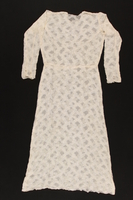
Patterned white gauze evening dress and sash brought with a Polish Jewish emigre
Object
Satin ring patterned evening dress with matching sash owned by Ella Brecher Lieberman when she emigrated with her husband and 9 year old daughter, Hanna, from Stanislawow, Poland (Sasiv, Ukraine), to Palestine in 1939.
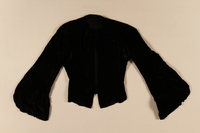
Black velvet two-piece cocktail dress brought with a Polish Jewish emigre
Object
Black velvet skirt and top owned by Ella Brecher Lieberman when she emigrated with her husband and 9 year old daughter, Hanna, from Stanislawow, Poland (Sasiv, Ukraine), to Palestine in 1939.
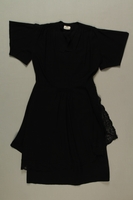
Black layered evening dress brought with a Polish Jewish emigre
Object
Black evening dress owned by Ella Brecher Lieberman when she emigrated with her husband and 9 year old daughter, Hanna, from Stanislawow, Poland (Sasiv, Ukraine), to Palestine in 1939.
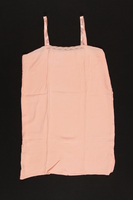
Peach foundation slip brought with a Polish Jewish emigre
Object
Peach slip owned by Ella Brecher Lieberman when she emigrated with her husband and 9 year old daughter, Hanna, from Stanislawow, Poland (Sasiv, Ukraine), to Palestine in 1939.
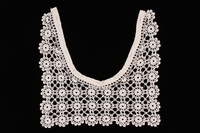
Woman's white crocheted dress collar brought with a Polish Jewish emigre
Object
Detachable lace collar owned by Ella Brecher Lieberman when she emigrated with her husband and 9 year old daughter, Hanna, from Stanislawow, Poland (Sasiv, Ukraine), to Palestine in 1939.
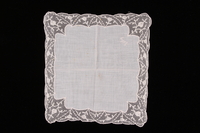
Embroidered white handkerchief with floral lace border brought with a Polish Jewish emigre
Object
Handkerchief embroidered with her name owned by Ella Brecher Lieberman when she emigrated with her husband and 9 year old daughter, Hanna, from Stanislawow, Poland (Sasiv, Ukraine), to Palestine in 1939.
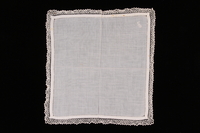
Embroidered white handkerchief with crochet border brought with a Polish Jewish emigre
Object
Handkerchief with a crocheted border and her name embroidered owned by Ella Brecher Lieberman when she emigrated with her husband and 9 year old daughter, Hanna, from Stanislawow, Poland (Sasiv, Ukraine), to Palestine in 1939.
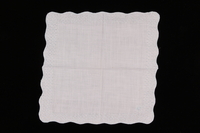
Embroidered white handkerchief with scalloped edge brought with a Polish Jewish emigre
Object
Embroidered handkerchief with her mongram owned by Ella Brecher Lieberman when she emigrated with her husband and 9 year old daughter, Hanna, from Stanislawow, Poland (Sasiv, Ukraine), to Palestine in 1939.
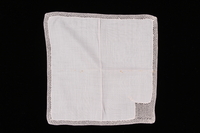
Embroidered white handkerchief with crocheted border brought with a Polish Jewish emigre
Object
Handkerchief embroidered with her initials owned by Ella Brecher Lieberman when she emigrated with her husband and 9 year old daughter, Hanna, from Stanislawow, Poland (Sasiv, Ukraine), to Palestine in 1939.
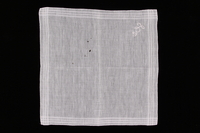
Embroidered white handkerchief with woven lines brought with a Polish Jewish emigre
Object
Embroidered woven handkerchief owned by Ella Brecher Lieberman when she emigrated with her husband and 9 year old daughter, Hanna, from Stanislawow, Poland (Sasiv, Ukraine), to Palestine in 1939.
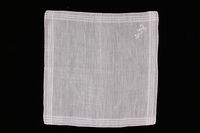
Embroidered white handkerchief with woven lines brought with a Polish Jewish emigre
Object
Embroidered handkerchief owned by Ella Brecher Lieberman when she emigrated with her husband and 9 year old daughter, Hanna, from Stanislawow, Poland (Sasiv, Ukraine), to Palestine in 1939.
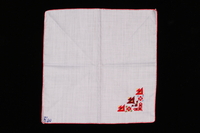
Handkerchief with multi-colored embroidery brought with a Polish Jewish emigre
Object
White handkerchief with multi-colored embroidery owned by Ella Brecher Lieberman when she emigrated with her husband and 9 year old daughter, Hanna, from Stanislawow, Poland (Sasiv, Ukraine), to Palestine in 1939.
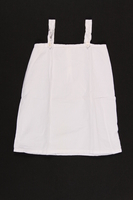
Child’s white summer dress brought with a Polish Jewish emigre
Object
Child’s spaghetti strap dress with embroidered initial owned by Ella Brecher Lieberman when she emigrated with her husband and 9 year old daughter, Hanna, from Stanislawow, Poland (Sasiv, Ukraine), to Palestine in 1939.
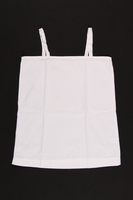
Child’s white summer dress with embroidered flowers brought with a Polish Jewish emigre
Object
Child’s spaghetti strap dress with embroidered flowers owned by Ella Brecher Lieberman when she emigrated with her husband and 9 year old daughter, Hanna, from Stanislawow, Poland (Sasiv, Ukraine), to Palestine in 1939.
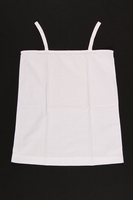
Child’s white summer dress with embroidered flowers brought with a Polish Jewish emigre
Object
Child’s spaghetti strap dress with embroidered flowers owned by Ella Brecher Lieberman when she emigrated with her husband and 9 year old daughter, Hanna, from Stanislawow, Poland (Sasiv, Ukraine), to Palestine in 1939.
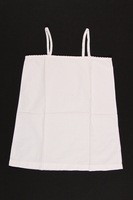
Child’s white dress with scalloped neckline brought with a Polish Jewish emigre
Object
Child’s spaghetti strap dress with a scalloped neckline owned by Ella Brecher Lieberman when she emigrated with her husband and 9 year old daughter, Hanna, from Stanislawow, Poland (Sasiv, Ukraine), to Palestine in 1939.
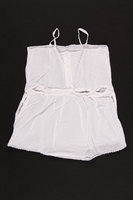
Child's white romper with embroidered flowers brought with a Polish Jewish emigre
Object
Child’s white embroidered romper owned by Ella Brecher Lieberman when she emigrated with her husband and 9 year old daughter, Hanna, from Stanislawow, Poland (Sasiv, Ukraine), to Palestine in 1939.
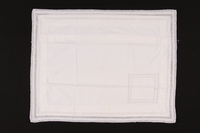
Embroidered white pillow sham brought with a Polish Jewish emigre
Object
White embroidered pillow sham owned by Ella Brecher Lieberman when she emigrated with her husband and 9 year old daughter, Hanna, from Stanislawow, Poland (Sasiv, Ukraine), to Palestine in 1939.
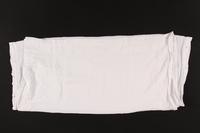
White bed sheet with embroidered flowers brought with a Polish Jewish emigre
Object
Embroidered bed linen owned by Ella Brecher Lieberman when she emigrated with her husband and 9 year old daughter, Hanna, from Stanislawow, Poland (Sasiv, Ukraine), to Palestine in 1939.
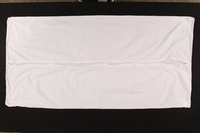
Monogrammed white garment bag brought with a Polish Jewish emigre
Object
Embroidered garment bag owned by Ella Brecher Lieberman when she emigrated with her husband and 9 year old daughter, Hanna, from Stanislawow, Poland (Sasiv, Ukraine), to Palestine in 1939.
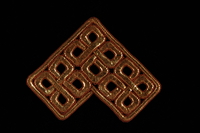
Metallic bronze tallit decoration of entwined squares brought with a Polish Jewish emigre
Object
Tallit [prayer shawl] needlework decoration made from bronze metallic thread in a geometric pattern owned by Ella Brecher Lieberman when she emigrated with her husband and 9 year old daughter, Hanna, from Stanislawow, Poland (Sasiv, Ukraine), to Palestine in 1939. It was made in Sasow, Poland, which was well known for its embroidered ritual objects. The applique would be attached to a corner of the tallit, a shawl worn by Jewish males during morning prayers.
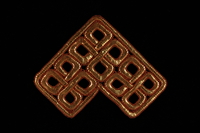
Metallic bronze tallit decoration of entwined squares brought with a Polish Jewish emigre
Object
Tallit [prayer shawl] needlework decoration made from bronze metallic thread in a geometric pattern by Ella Brecher Lieberman when she emigrated with her husband and 9 year old daughter, Hanna, from Stanislawow, Poland (Sasiv, Ukraine), to Palestine in 1939. It was made in Sasow, Poland, which was well known for its embroidered ritual objects. The applique would be attached to a corner of the tallit, a shawl worn by Jewish males during morning prayers.
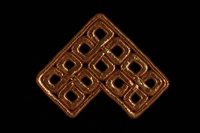
Metallic bronze tallit decoration of entwined squares brought with a Polish Jewish emigre
Object
Tallit [prayer shawl] needlework decoration made from bronze metallic thread in a geometric pattern owned by Ella Brecher Lieberman when she emigrated with her husband and 9 year old daughter, Hanna, from Stanislawow, Poland (Sasiv, Ukraine), to Palestine in 1939. It was made in Sasow, Poland, which was well known for its embroidered ritual objects. The applique would be attached to a corner of the tallit, a shawl worn by Jewish males during morning prayers.
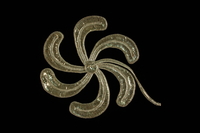
Metallic silver pinwheel tallit decoration brought with a Polish Jewish emigre
Object
Tallit [prayer shawl] pinwheel shaped needlework decoration made from metallic silver thread owned by Ella Brecher Lieberman when she emigrated with her husband and 9 year old daughter, Hanna, from Stanislawow, Poland (Sasiv, Ukraine), to Palestine in 1939. It was made in Sasow, Poland, which was well known for its embroidered ritual objects. The applique would be attached to a corner of the tallit, a shawl worn by Jewish males during morning prayers.
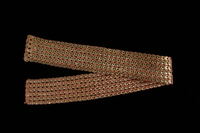
Metallic pink and yellow tallit atarah brought with a Polish Jewish emigre
Object
Tallit (prayer shawl) needlework atarah (neckband) decoration made from silver and pink metallic thread owned by Ella Brecher Lieberman when she emigrated with her husband and 9 year old daughter, Hanna, from Stanislawow, Poland (Sasiv, Ukraine), to Palestine in 1939. It was made in Sasow, Poland, which was well known for its embroidered ritual objects. The atarah would be attached to the interior top center of the tallit worn by Jewish males during morning prayers, where it would be nearest the head when the shawl is draped over it.
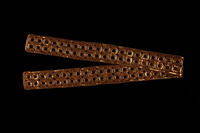
Metallic brown tallit atarah brought with a Polish Jewish emigre
Object
Tallit [prayer shawl] decoration owned by Ella Brecher Lieberman when she emigrated with her husband and 9 year old daughter, Hanna, from Stanislawow, Poland (Sasiv, Ukraine), to Palestine in 1939. It was made in Sasow, Poland, which was well known for its embroidered ritual objects. The applique would be attached to a corner of the tallit, a shawl worn by Jewish males during morning prayers.



